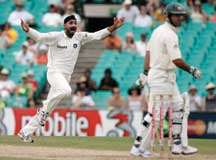Magazine
Rebirth At Perth?

Team India's historic victory in the Perth Test against Australia has sadly been obscured by controversies on and off the field.
|
Much like the country’s premier bourse – the Bombay Stock Exchange – Indian cricket is lunging from one crisis to another. As I write this on the evening of January 23, the eve of the fourth and final Test Match at Adelaide against Australia, there is more stuff in the newspapers and in the electronic media about the supposed rifts within the Indian cricket team than about its preparation for a potentially exciting finale to the Test series. The latest ruckus centers on the selection of the team for the triangular one-day-international (ODI) series in which India faces Sri Lanka and Australia soon after its Test series against the hosts. By dropping three of the veteran quartet of star batsmen – Saurav Ganguly, Rahul Dravid, V.V.S.Laxman, and Sachin Tendulkar – the Indian selectors unwittingly pried open a Pandora’s Box.
True, one could have opted to retain one or even two of the dropped in-form veterans, considering they have obviously acclimatized themselves to the trying Australian conditions. But when a debate of this sort generates more heat than light, pertinent points tend to be lost. For instance, test cricket calls for a different emphasis on a player’s skills than do One-Dayers, and the seniors are not famous for their agility in the field. Also, if India’s One-Day skipper Mahendra Singh Dhoni wants a side of his choice – which does not include the above trinity of veterans -so be it. A captain can, and usually should, call the shots for team composition. Sadly, the ODI selection imbroglio overshadowed a remarkable Indian win in the third test match in the series. Remarkable enough for commentators such as Sunil Gavaskar (one of the few observers of the game with a keen sense of history) to call it the greatest ever since Indian cricket first tasted a series victory on foreign soil in 1971. The Perth victory was sweet revenge not only against an unsportsmanlike and boorish Australian team, but also against at least a dozen umpiring decisions that went against the Indians in the second Test at Sydney which, in fairer circumstances, we should have won or, at the very least, honorably drawn. Journalism, it is often said, is history in a hurry. If so, it isn’t at all surprising that the reports and analyses of the Perth Test have missed its historical significance. It is commonplace to overlook the significance of an event, particularly when it is preceded and followed by the “noise” of the surrounding controversy. I’d go a step further than Mr.Gavaskar. Perth signifies a new chapter in Indian cricket, a renaissance of sorts. No, don’t look at the scores to know why. There wasn’t a single century scored in that test, nor a single five-wicket haul which, for the uninitiated, is the bowling equivalent of a batsman’s century. The absence of individual dominance over the match, in fact, could at best be a pointer to collective effort. But the real reasons transcend the material aspects of the game. To know their significance, let me trace the events that led to this remarkable contest. The Indians came to Perth after a harrowing experience at Sydney where we lost, not to a better cricketing opponent but to a couple of lousy umpires. Worse, Harbhajan Singh was slapped with a match-ban for an allegedly racist remark against Andrew Symonds on the field during the Sydney Test. The ban (later suspended) came from the International Cricket Council (ICC) matchreferee Mike Proctor, who, like the rest of us, saw nothing untoward on television. Furthermore, the umpires admitted they neither heard nor saw anything that was incriminatory enough to be reported for disciplinary sanctions by ICC (see sidebar). Despite this, Proctor accepted the version of the Australian players and dismissed that of Sachin Tendulkar, the only Indian cricketer on the field at the time, aside from Singh. Was Harbhajan being framed by the Aussies because he has been tormenting Aussie skipper and leading batsman Ricky Ponting with his spin-bowling guile? Did Harbhajan, in a straight-faced exchange of swear-words with Symonds say “teri maa ki” which the latter, an Australian of aborigine extraction, heard as “monkey”? We can only speculate on the basis of unconfirmed insider whispers. What we do know however, is that the Indian team was understandably hurt by the insult of the undeserved one-sided ban on top of the injury of the loss as a result of the one-sided umpiring at Sydney. The team had the option of packing the bags and returning home in the wake of the tensions between the opposing teams as well as over the umpires. Instead the boys played out of their skins to beat the Australians convincingly in the next Test match barely a week later. That a team often ridiculed in the past – including by this writer – for its seemingly spineless display of cricket in crunch situations, should steel itself and fight like wounded tigers to subjugate the world’s highest ranked (and worst-behaved) team speaks of a remarkable transformation. Perth was a rite of passage, in a manner of speaking, for a bunch of boys who walked through the fire of unforeseen adversity and emerged as a team of dignified mature men. For sure, earlier teams have tasted test match victories. For sure, many of those wins were severe contests of on-field nerve and temperament. But I’m not so sure any of them was such a gruelling test of character, such a resounding affirmation of self belief.
|


You must be logged in to post a comment Login